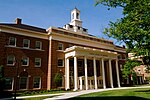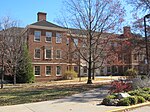Miami University (informally Miami of Ohio or simply Miami) is a public research university in Oxford, Ohio. The university was founded in 1809, making it the second-oldest university in Ohio (behind Ohio University, founded in 1804) and the 10th oldest public university (32nd overall) in the United States. The school's system comprises the main campus in Oxford, as well as regional campuses in nearby Hamilton, Middletown, and West Chester. Miami also maintains an international boarding campus, the Dolibois European Center in Differdange, Luxembourg. It is classified among "R2: Doctoral Universities – High research activity".Miami University provides a liberal arts education; it offers more than 120 undergraduate degree programs and over 70 graduate degree programs within its 7 schools and colleges in architecture, business, engineering, humanities and the sciences. Miami was one of the original eight Public Ivy schools, a group of publicly funded universities considered as providing a quality of education comparable to those of the Ivy League.Miami University has a long tradition of Greek life; five social Greek-letter organizations were founded at the university earning Miami the nickname "Mother of Fraternities". Today, Miami University hosts over 50 fraternity and sorority chapters, and approximately one-third of the undergraduate student population are members of the Greek community.Miami's athletic teams compete in the National Collegiate Athletic Association (NCAA) Division I and are collectively known as the Miami RedHawks. They compete in the Mid-American Conference in all varsity sports except ice hockey, which competes in the National Collegiate Hockey Conference.








